 | |
| Website | www |
|---|---|
| Durban Club | |
|---|---|
 | |
| General information | |
| Status | Complete |
| Type | Business-use |
| Location | Durban, South Africa |
 | |
| Website | www |
|---|---|
| Durban Club | |
|---|---|
 | |
| General information | |
| Status | Complete |
| Type | Business-use |
| Location | Durban, South Africa |
In May 1854 Durban had a population of 1,204 settlers which meant that it qualified to be elevated to the status of a Borough. On 14 June 1854, 20 prominent Durban residents signed an agreement to form the first D'Urban Club, named after Sir Benjamin D'Urban, Governor of the Cape Colony. The newly formed club was to be used for the playing of billiards, chess and as a reading and newsroom.

Durban is the third most populous city in South Africa—after Johannesburg and Cape Town—and the largest city in the South African province of KwaZulu-Natal. Located on the east coast of South Africa, Durban is famous for being the busiest port in the country. It is also seen as one of the major centres of tourism because of the city's warm subtropical climate and extensive beaches. Durban forms part of the eThekwini Metropolitan Municipality, which includes neighboring towns and has a population of about 3.44 million, making the combined municipality one of the biggest cities on the Indian Ocean coast of the African continent. It is also the second most important manufacturing hub in South Africa after Johannesburg. In 2015, Durban was recognised as one of the New7Wonders Cities.
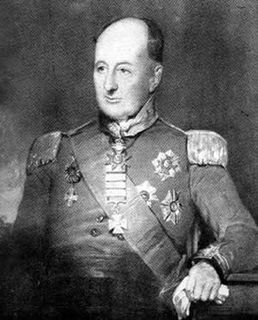
Lieutenant General Sir Benjamin Alfred D'Urban was a British general and colonial administrator, who is best known for his frontier policy when he was the Governor in the Cape Colony.

The Cape of Good Hope, also known as the Cape Colony, was a British colony in present-day South Africa, named after the Cape of Good Hope. The British colony was preceded by an earlier Dutch colony of the same name, the Kaap de Goede Hoop, established in 1652 by the Dutch East India Company. The Cape was under Dutch rule from 1652 to 1795 and again from 1803 to 1806. The Dutch lost the colony to Great Britain following the 1795 Battle of Muizenberg, but had it returned following the 1802 Peace of Amiens. It was re-occupied by the UK following the Battle of Blaauwberg in 1806, and British possession affirmed with the Anglo-Dutch Treaty of 1814.
In February 1855 a piece of land was purchased in Smith Street from the widow Strydom for £15. The clubhouse they built was a wood and thatch structure measuring 30 feet (9.1 m) by 20 feet (6.1 m). [1] The walls and "bafta" ceilings were covered in Sanderson's wallpaper. The ground was hardened with lime refuse and the property was enclosed with 51 yards (47 m) of post and rail fencing.
In 1861 the members decided that a new, more permanent clubhouse needed to be built. They bought a piece of land adjoining the first clubhouse for £1,045 and a new double story clubhouse was built. The Natal Mercury of October 2, 1863 described it "The new club, with its handsome pilastered front, is taken altogether, the finest building in town." In 1879 the club was extended by duplicating the frontage of the building westward with a porch and vestibule in between. The new wing replaced the old wood and thatch building which had housed the billiard room and library.

The Mercury, formerly The Natal Mercury, is an English-language newspaper owned by Independent News & Media and published in Durban, South Africa.
In 1898 plans were drawn for a new club to be built on land bought for £8,000 behind the existing clubhouse. The Second Boer War broke out in 1899 and work was delayed until October 1900. The present clubhouse was finally completed and occupied in January 1904. The new clubhouse is of Edwardian, free Renaissance style with capitals, arches, pilasters and mouldings. The hardwood doors in the main foyer had to be carved on the curve and the staircase, with its modern hand joined balustrade was greatly admired. The beautifully carved fireplaces are fully functional.

The Second Boer War was fought between the British Empire and two Boer states, the South African Republic and the Orange Free State, over the Empire's influence in South Africa. It is also known variously as the Boer War, Anglo-Boer War, or South African War. Initial Boer attacks were successful, and although British reinforcements later reversed these, the war continued for years with Boer guerrilla warfare, until harsh British counter-measures brought them to terms.

The Edwardian era or Edwardian period of British history covers the brief reign of King Edward VII, 1901 to 1910, and is sometimes extended in both directions to capture long-term trends from the 1890s to the First World War. The death of Queen Victoria in January 1901 marked the end of the Victorian era. Her son and successor, Edward VII, was already the leader of a fashionable elite that set a style influenced by the art and fashions of continental Europe. Samuel Hynes described the Edwardian era as a "leisurely time when women wore picture hats and did not vote, when the rich were not ashamed to live conspicuously, and the sun really never set on the British flag."
The stables were converted in 1917 to house member's cars and this garage was enlarged and improved in 1922 and 1928. A squash court was built in 1922 and this is now the laundry. In 1939 an ambitious project was undertaken to build 23 new bedrooms over the existing clubhouse. A new dining suite was built and a new, larger bar was built in the courtyard. In 1956 the upstairs snack lounge and veranda was converted into a grill room to include amenities for women.
From the early days of the second clubhouse, women were allowed to attend functions and dinners at the clubhouse. From 1911, Wednesday nights became "ladies nights". Women were not allowed to become full members of the club until July 1994. [2] In 1997 it was proposed that the Durban Club be sold to a hotel group who would preserve and refurbish it, incorporating it into the construction on the site of a 17 story 5 star hotel. The Durban Club was to continue to function in a limited way and would be a client of the hotel. This arrangement fell through and the following year a second bid was made to purchase the club from the members. This bid also fell through and a new committee was formed to turn the Club around. The club has undergone extensive refurbishment and improvements during the past year. In 2003 the building was sold and the Durban Club obtained a 99-year lease on part of the building.
The facilities of the Club include an ongoing arrangement with the Durban Manor, which now owns the building, to provide accommodation on a Bed and breakfast basis for club members and reciprocity members in the bedroom wing of the building which has 21 bedrooms of three star rating, all with bathrooms.

A bed and breakfast is a small lodging establishment that offers overnight accommodation and breakfast. Bed and breakfasts are often private family homes and typically have between four and eleven rooms, with six being the average. In addition, a B&B usually has the hosts living in the house.

The Free Trade Hall on Peter Street, Manchester, England, was a public hall, constructed in 1853–56 on St Peter’s Fields, the site of the Peterloo Massacre. It is now a Radisson hotel.
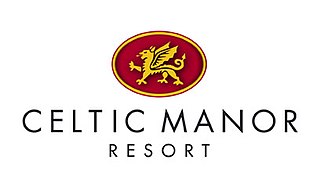
Celtic Manor Resort is a golf, spa and leisure hotel and resort in Newport, South East Wales. It consists of three hotels, a country inn, luxury lodges, two spas, six restaurants, three championship golf courses, two golf and country clubhouses, high ropes courses, adventure golf, laser tag, archery and a multi-purpose conference centre. It was the venue for the 2010 Ryder Cup, the first to be held in Wales, and hosted the 2014 NATO summit.

Doudeville is a commune in the Seine-Maritime department in the Normandy region in northern France.
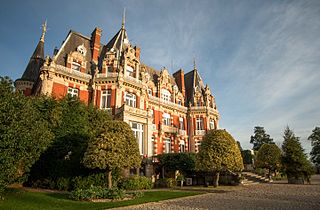
Chateau Impney Hotel & Exhibition Centre is a Grade II* listed 19th-century house built in the style of an elaborate French château near Droitwich Spa in Worcestershire, England. Of the large mansions in Worcestershire supported by industrial fortunes, Sir Nicolas Pevsner judged Impney to be "the showiest of them all in the county". Once a family home for local industrialist John Corbett, Chateau Impney has been a hotel since 1925.
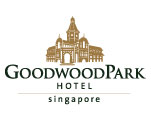
The Goodwood Park Hotel is a heritage hotel in Singapore, situated in a 6-hectare landscaped garden on Scotts Road. It was first built as the club house for the Teutonic Club serving the expatriate German community in Singapore, and later converted into a hotel.

The University Cottage Club is one of eleven current eating clubs at Princeton University, in Princeton, New Jersey, United States. It is also one of the six bicker clubs, along with The Ivy Club, Tiger Inn, Cap and Gown Club, Cannon Club and Tower Club.

The Grand Brighton Hotel is a historic Victorian sea front hotel in Brighton on the south coast of England. Designed by John Whichcord Jr. and built in 1864, it was intended for members of the upper classes visiting the city, and remains one of Brighton's most expensive hotels.

The Moor Hall is a 1905 house, built for Colonel Edward Ansell of Ansells Brewery, in Sutton Coldfield, Birmingham, England. It has been used as a hotel since 1930 and subsequently extended. It is on the site of a former 15th century building.
The Lakeside Leisure Complex is a hotel, entertainment and leisure complex in the village of Frimley Green near Camberley in west Surrey. It is most famous as being the venue of the BDO World Darts Championship, holding both men's and women's events.
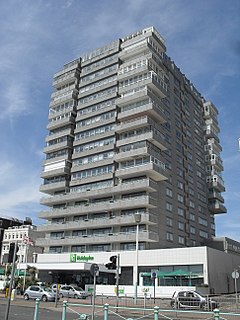
The Bedford Hotel is a hotel on the seafront in Brighton, England which has subsequently been renamed the Holiday Inn Brighton after becoming a part of the Holiday Inn business.
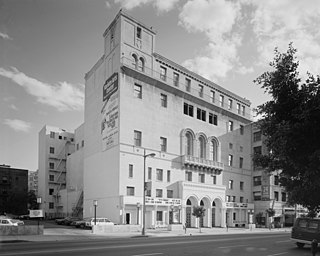
The Friday Morning Club building is located in Downtown Los Angeles at 940 South Figueroa Street, in Los Angeles, California. It was the second home of the women's club also named the Friday Morning Club (FMC), for 61 years.
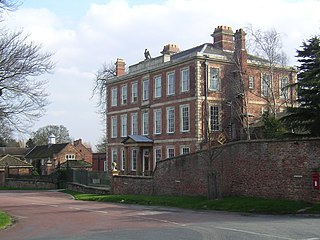
Middlethorpe Hall is a 17th-century country house standing in 20 acres of grounds in Middlethorpe, York, North Yorkshire, England. It is currently used as a hotel.
Como Orchards Club, designed by Frank Lloyd Wright in 1909 and located near Darby, Montana, was part of a land development scheme inspired by the western railroad expansion.

The Royal Albion Hotel is a 3-star hotel in the seaside resort of Brighton, part of the English city of Brighton and Hove. Built on the site of a house belonging to Richard Russell, a local doctor whose advocacy of sea-bathing and seawater drinking helped to make Brighton fashionable in the 18th century, it has been extended several times, although it experienced a period of rundown and closure in the early 20th century. A fire in 1998 caused serious damage, but the hotel was restored.

The Outing Club is located in the central part of Davenport, Iowa, United States. It has been listed on the National Register of Historic Places since 1977. In 1985 it was included as a contributing property in the Vander Veer Park Historic District.

Taj Connemara, Chennai is a five-star hotel in Chennai, India. It is a heritage hotel in Chennai. Classified under the Taj Group's business hotels section, the hotel is considered the oldest hotel in the city.

The Wauwatosa Woman's Club Clubhouse is located in Wauwatosa, Wisconsin. It was added to the National Register of Historic Places in 1998.

The Grand Hotel is a Grade II* listed Victorian hotel in the city centre of Birmingham, England. The hotel occupies the greater part of a block bounded by Colmore Row, Church Street, Barwick Street and Livery Street and overlooks St Philip's Cathedral and churchyard. Designed by architect Thomson Plevins, construction began in 1875 and the hotel opened in 1879. Extensions and extensive interior renovations were undertaken by prominent Birmingham architecture firm Martin & Chamberlain from 1890 to 1895. Interior renovations included the building of the Grosvenor Room which boasts rich and impressive Louis XIV style decoration.

Sleepy Hollow Country Club is a historic country club in Scarborough-on-Hudson in Briarcliff Manor, New York. The club was founded in 1911, and its clubhouse was known as Woodlea, a 140-room Vanderbilt mansion owned by Colonel Elliott Fitch Shepard and his wife Margaret Louisa Vanderbilt Shepard. It was built in 1892–95 at a cost of $2 million and was designed by the architectural firm McKim, Mead & White; the estate became a contributing property to the Scarborough Historic District in 1984.

The Midwest Oil Company Hotel, at 136 East 6th Street in Casper, Wyoming, is an historic hotel building which was listed on the National Register of Historic Places in 1983. It has also served as the Casper Women's Club House. Originally built by the Midwest Oil Company to accommodate workers during the Casper oil boom, it was taken over by Standard Oil Company of Indiana when that company bought Midwest Oil. In the 1930s, in the waning days of oil production in Natrona County, a local women's organization bought the hotel for $8,000 and was renamed the Casper Women's Club House.